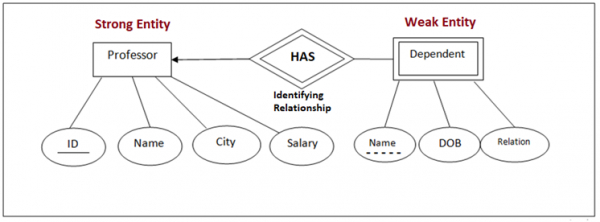
 Data Structure
Data Structure Networking
Networking RDBMS
RDBMS Operating System
Operating System Java
Java MS Excel
MS Excel iOS
iOS HTML
HTML CSS
CSS Android
Android Python
Python C Programming
C Programming C++
C++ C#
C# MongoDB
MongoDB MySQL
MySQL Javascript
Javascript PHP
PHP
- Selected Reading
- UPSC IAS Exams Notes
- Developer's Best Practices
- Questions and Answers
- Effective Resume Writing
- HR Interview Questions
- Computer Glossary
- Who is Who
Identifying Entity Relationships in DBMS
Identifying entity relationships in DBMS is used to identify a relationship between strong and weak entity.
Before beginning, let us take an example of Professor entity, which is our Strong Entity, with Professor_ID as a Primary Key −
|
Professor_ID |
Professor_Name |
Professor_City |
Professor_Salary |
The weak entity is Professor_Dependents entity:
|
Name |
DOB |
Relation |
Now, let us continue,
Weak Entity
Weak Entity is dependent on Strong Entity and does not have a primary key. Weak Entity has a partial key. It is represented as double rectangle −

Strong Entity
Other entities are dependent on Strong Entity and it has a key attribute i.e. a primary key and represented as a single rectangle.

Identifying Relationships
It links the strong and weak entity and is represented by a double diamond sign.
Let us see with an example to link both the entities using Identifying Relationships:

Above we saw that, Dependent Name could not exist on its own but in relationship to a Professor.
Rest, the following we used in our E-R Diagram −
| Professor |
Strong Entity |
| Dependent |
Weak Entity |
| Partial Key (Weak Entity) |
Name |
| Primary Key (Strong Entity) |
ID |

